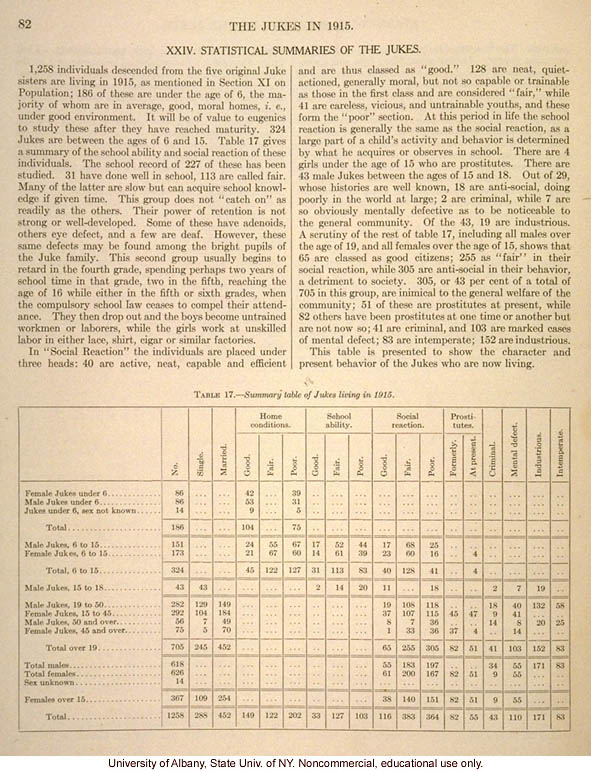82 The Jukes in 1915.
XXIV. Statistical Summaries of the Jukes.
1,258 individuals descended from the five original Juke sisters are living in 1915, as mentioned in Section XI on Population; 186 of these are under the age of 6, the majority of whom are in average, good, moral homes, i.e., under good environment. It will be of values to eugenics to study these after they have reached maturity. 324 Jukes are between the ages of 6 and 15. Table 17 gives a summary of the school ability and social reaction of these individuals. The school record of 227 of these has been studied. 31 have done well in school, 113 are called fair. Many of the latter are slow but can acquire school knowledge if given time. This group does not "catch on" as readily as the others. Their power of retention is not strong or well-developed. Some of these have adenoids, other eye defect, and a few are deaf. However, these same defects may be found among the bright pupils of the Juke family. The second group usually begins to retard in the fourth grade, spending perhaps two years of school time in that grade, two in the fifth, reaching the age of 16 while either in the fifth or sixth grades, when the compulsory school law ceases to compel their attendance. The then drop out and the boys become untrained workmen or laborers, while the girls work at unskilled labor in either lace, cigar or similar factories.
In "Social Reaction" the individuals are placed under three heads: 40 are active, neat, capable and efficient and are thus classed as "good." 128 are neat, quiet-actioned, generally moral, but not so capable or trainable as those in the first class and are considered "fair," while 41 are careless, vicious, and untrainable youths, and these form the "poor" section. At this period in life the school reaction is generally the same as the social reaction, as a large part of a child's activity and behavior is determined by what he acquires or observes in school. The are 4 girls under the age of 15 who are prostitutes. There are 43 male Jukes between the ages of 15 and 18. Out of 29, whose histories are well known, 18 are anti-social, doing poorly in the world at large; 2 are criminal, while 7 are so obviously mentally defective as to be noticeable to the general community. Of the 43, 19 are industrious. A scrutiny of the rest of table 17, including all males over the age of 19, and all females over the age of 15, shows that 15 are classified as good citizens; 255 as "fair" in their social reaction, while 305 are anti-social in their behavior, a detriment to society. 305, or 43 per cent of a total of 705 in this group, are inimical to the general welfare of the community; 51 of these are prostitutes at present, while 82 others have been prostitutes at one time or another but are not now so; 41 are criminal, and 103 are marked cases of mental defect; 83 are intemperate; 152 are industrious.
This table is presented to show the character and present behavior of the Jukes who are now living.
[tabular material]
Table 17. - Summary table Jukes living in 1915.
[end tabular material]
[end]


